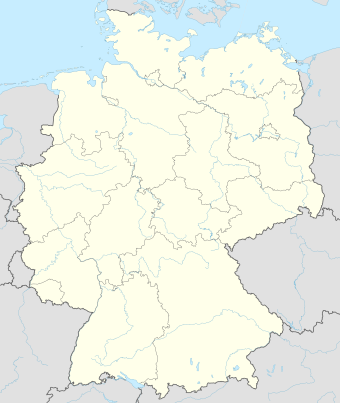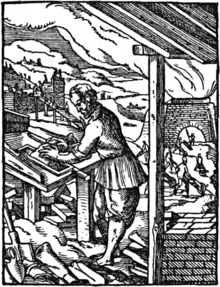Clay brick industry
As part of the building materials, stone and earth industry ( building materials industry for short ), the clay brick industry is one of the classic industrial sectors. Around 1500 industrial employees produce clay blocks in 30 companies at 49 locations across Germany . The gross value added in the industry, including all supplementary products, is around 450 million euros per year. In 2016, 7.225 million m³ of masonry bricks with a production value of 599 million euros were produced in Germany. The proportion of clay blocks is 6.094 million m³ with a production value of 398 million euros.
With continuous innovations, the clay brick industry, as a supplier to the construction industry, makes an important contribution to overcoming fundamental social challenges such as climate protection .
Industry
Production sites for clay blocks in Germany |
Company and locations
The industry is strongly characterized by medium-sized companies. Many of the 30 brick manufacturing companies are owner-managed or family-run and have existed for several generations. Because of the clay deposits required for production, the companies mostly operate in regional markets and are spread over 49 locations with a total of around 1,500 employees. Only 4 percent of brick manufacturers have more than 100 employees, 32 percent fewer than 20 employees, 64 percent 20 to 100 employees.
Corporate groups
Essential company and product groups in the brick industry are the
- German Poroton
- Wienerberger, batsman Poroton
- Unipor
- Leipfinger Bader, Bergmann Ziegelwerke, Hörl & Hartmann, Alten Ziegel, Franz Wenzel brickworks, Anton Hanrieder, Pasel & Lohmann, Wöhrl, Schmid brickworks
- Thermopor
- Brickworks Eder, Röben, Girnghuber, Kormann, Brickworks Aubenhahn, Brickworks Turber, Brickworks Staudacher, Rapis Bricks, Erbersdobler, Brickworks Nordhausen
- My brick house
- Brickworks Bellenberg, Juwö Poroton, Klosterbeuren , Lücking, Stengel, Zeller Poroton.
Brick systems Michael Kellerer, the Englert brickworks and the Ott Deisendorf brickworks operate as independent companies.
Associations and Organizations
- Federal Association of the German Brick Industry
- Working group for masonry bricks
- Association of the brick industry north
- Association of the Northwest brick and tile industry
- Association of Brick and Tile Industry Southwest
- Bavarian brick industry association
- Brick center south
- DGfM German Society for Masonry and Housing Construction
- Federal Association of Building Materials - Stones and Earth
Information campaign "Habitat Bricks"
Habitat Bricks is an information and marketing campaign launched by the German clay brick industry in 2015.
The four product groups of the brick industry Deutsche Poroton, Mein Ziegelhaus, Unipor and Thermopor represent manufacturer-independent properties and possible uses of the building material brick. The central element is the online portal with information for civil engineers, architects, multipliers, investors, decision-makers and private builders. It offers references from all regions of Germany, an overview of brick-loving architects and construction companies with a targeted search function as well as a brick lexicon. As part of a cooperation, the Bauherrenschutzbund e. V. provides a guidebook on consumer protection.
Competitions and Prizes
The German Brick Prize is the most famous architecture prize in the industry. The Brick Center South has been praising it since 2011 in cooperation with the Federal Ministry of Construction. Every four years, the award is given to brick buildings that are committed to sustainable building in ecological, economic and socio-cultural terms and contribute to the design of public spaces.
history
The oldest brick in the world was found during archaeological excavations in Jericho and dates back to 7500 BC. Dated. Then as now, this building material is formed from the four basic elements fire, water, air and earth. The manufacturing process has been improved in many innovative steps since the beginning of industrialization and is now a highly modern production process in fully automated brickworks.

Industrial brick production in the 19th and 20th centuries
Up until the 19th century, brick production was largely characterized by secondary farms and small brick shops that were run by hand.
The actual transition from artisanal to industrial brick production began around the middle of the 19th century. The extraordinarily strong increase in the population, the onset of industrialization and the brisk construction activity in the rapidly growing cities created such a high demand for masonry bricks that numerous new brick factories were founded.
The use of steam engines for clay processing from 1843, the invention of the screw press and the invention of the ring kiln by Friedrich Hoffmann in 1858 made it possible to build brickworks with high capacities from the middle of the 19th century. The fully automatic "Type Hörstel" presented in 1910 already managed the entire transport between the press and the depositing point and is thus a forerunner of today's fully automatic plant. After the First World War, large quantities of bricks were required and indoor furnaces were developed for outputs of up to 100,000 bricks per day.
After the end of the Second World War, brick production was increasingly automated. The great need for building material for 4,000,000 missing apartments meant that the brick industry developed into a modern industry and the first electronically controlled, fully automatic plants were built. Technical progress was mainly characterized by the development and introduction of the tunnel oven in the 1950s, the setting machine in the 1960s and the de-stacking machine in the 1970s. The first automated brickworks began to emerge in the 1950s, and full automation took place from the late 1960s.
Technological development was associated with a strong process of concentration in the brick industry, that is, the number of factories fell, but the remaining factories and, above all, the production volumes grew. While there were 17,800 plants at the end of the 19th century, clay blocks are still produced at 49 locations in Germany today. The oldest producing brick factories are Schmid in Bönnigheim and Stengel in Donauwörth.
Publications
- Trade magazine "Zi Ziegelindustrie International"
- Trade journal "Mauerwerk - European Journal of Masonry"
- Zi yearbook
- Magazine "Naturally Bricks" https://www.lebensraum-ziegel.de/fileadmin/user_upload/Dokumente/Downloads/Natuerlich_Ziegel.pdf
- Magazine for architects and building planners "City and Bricks" 01/2018 https://www.lebensraum-ziegel.de/fileadmin/user_upload/Dokumente/Downloads/Stadt_und_Ziegel_01-2018.pdf
literature
- Peter Bachmann and Matthias Lange (eds.): Build healthily with safety, Springer Vieweg, 2nd edition, Wiesbaden 2013
- W. Bender: Popular errors in the history of brickwork technology, in: ZI 12/2006
- Bundesverband Baustoffe - Steine und Erden e. V. (Ed.): Economic portrait of the German building materials industry, author Michael Grömling, Institute of the German Economy Cologne, Berlin 2011
- Federal Association of the German Brick and Tile Industry V. (Ed.): The history of brick production, edited by Erwin Rupp and Günther Friedrich, 3rd edition, Bonn 1993
- Federal Association of the German Brick and Tile Industry V. (Ed.): From the brick god to the industrial electronics technician - history of brick production from the beginnings to the present day, text / image / editor Willi Bender, Bonn 2004
- Ziegel Zentrum Süd e. V. (Ed.): Ziegellexikon Mauerwerk 2014/15, author Michael Pröll, Munich 2014
Web links
- Federal Association of the German Brick and Tile Industry V.
- Working group for brickwork in the Federal Association of the German Brick Industry V.
- Research Association of the Brick Industry e. V.
- Institute for Brick Research Essen eV
- Information and marketing campaign of the German clay block industry "Habitat Bricks"
Individual evidence
- ↑ a b Unique information portal on the brick launched. Retrieved March 30, 2016 .
- ↑ Federal Association of the German Brick and Tile Industry e. V. (Ed.): Half-year report 2017 . Bonn 2017, p. 26-27 .
- ↑ Michael Grömling: Economic portrait of the German building materials industry . Ed .: Bundesverband Baustoffe - Steine und Erden e. V. Institute of the German Economy Cologne, Berlin 2011, p. 4 .
- ↑ Michael Grömling: Economic portrait of the German building materials industry . Ed .: Bundesverband Baustoffe - Steine und Erden e. V. Institute of the German Economy Cologne, Berlin 2011, p. 30 .
- ↑ German Brick Prize. Retrieved June 18, 2019 .
- ↑ Willi Bender: From the brick god to the industrial electronics technician - history of brick production from the beginning until today . Ed .: Federal Association of the German Brick and Tile Industry e. V. Bonn 2004, p. 69 .
- ↑ Willi Bender: From the brick god to the industrial electronics technician - history of brick production from the beginning until today . Ed .: Federal Association of the German Brick and Tile Industry e. V. Bonn 2004, p. 70 .
- ↑ a b Erwin Rupp and Günther Friedrich: The history of brick production . Ed .: Federal Association of the German Brick and Tile Industry e. V. 3rd edition. Bonn 1993, p. 76 .
- ↑ Erwin Rupp and Günther Friedrich: The history of brick production . Ed .: Federal Association of the German Brick and Tile Industry e. V. 3rd edition. Bonn 1993, p. 78 .
- ↑ Willi Bender: From the brick god to the industrial electronics technician - history of brick production from the beginning until today . Ed .: Federal Association of the German Brick and Tile Industry e. V. Bonn 2004, p. 405 .




